Course
-
- USMMA: Teaching with Simulation in the Maritime Field Maritime Reporter, Oct 2020 #18
A great deal of research related to student learning styles has emerged in recent years. Through that research strong arguments have been made that more kinesthetic learning methods, such as hands-on or experiential learning, are more effective than more traditional methods like the lecture. In the maritime field, technology such as simulation, has provided us with tools to harness the power of experiential learning; however, those tools alone cannot ensure students are learning effectively.
Studies by the National Training Laboratory have found methods such as lecturing and reading result in only 5%-10% of knowledge retention; whereas, immersive learning can yield knowledge retention rates of 75% or better. These beliefs have become even more deeply rooted given wide variety of tools that technology has afforded the classroom. Many professional disciplines, including the medical, airline, and maritime fields, have adopted technologies like simulation for this reason. Simulation provides an immersive learning environment that can place students in virtual real-life experiences. It is a popular belief that this greatly improves knowledge retention, and makes the learning experience more enjoyable and engaging.
Despite such beliefs there has been contradictory evidence to the relative effectiveness of different learning styles. Some studies have found that, although a student might “prefer”’ a particular type of learning method over another, it does not necessarily mean that any one is a more effective than another. One study conducted at Indiana University with 400 students found that, although students had “preferred” learning styles which included visual, auditory, reading/writing, and kinesthetic (or VARK) there wasn’t a significant difference in outcomes for any particular style or combination of styles. Moreover, almost 70% of the students in the study chose not to use their reported preferred learning style when given the option and those that did utilize their preferred learning style did not show better outcomes. Therefore, it is imperative to recognize that simulation is a tool in the learning process that must be supported by other teaching techniques in order to be effective and is not just a better learning method. A comprehensive course design that utilizes multiple learning methods in combination with technology should best prepare students to achieve desired outcomes.
Before we enter into any learning environment we must first have an understanding of our learning outcomes and objectives, though. Learning outcomes define what the student should know or be able to do at the end of the course. Because of this, outcomes must be specific and measurable in order to determine whether or not learning has been successful. Objectives, on the other hand, are more aspirational and define what we intend to do when we set out at the beginning of a course. For example, an outcome for a Bridge Resource Management course might be to “demonstrate proper implementation of the rules of the road”; whereas the objective might be to “encounter vessels with risk of collision while standing a watch”. Together, learning outcomes and objectives give both the instructor and student a clear indication of why they are engaging in learning and what the student can expect to be able to do at the end of that learning.
In my professional career as a mariner, I often said that the best time I ever spent in any class was in a simulator. That is a broad statement, though, as not all simulation courses have the same objectives. Objectives in a Bridge Resource Management course might be to “develop teamwork, improve the cognitive function of the watch officer, and develop skills for managing stress on the bridge”; whereas, the objective for a Shiphandling course might be to “execute proper anchoring techniques, develop an understanding of bank effect and interaction with other vessels, or demonstrate the proper use of azipod propulsion”. Although the objectives are different for each of these courses, they use a common technological component and could have a similar course structure supported by that technology. The benefit of simulation as a technique in each of these courses is the ability to place the student in specific scenarios that mimic real life situations and allow them to actually apply learned skills to achieve a desired result. This is one of the reasons I found simulation to be such a valuable experience in my professional learning: it offered validation and reinforcement to what I had already learned. Consequently, just as simulation can effectively reinforce the skills we need to be competent professionals, it can also reinforce bad habits or improper skills. As the saying goes, practice can make perfect, but imperfect practice will lead to imperfect performance.
This is why course outcomes and objectives must be supported by sound course design, reliable content, and competent instructors; not simply be dependent upon the simulation technology. Before simulation can be incorporated as a tool in a course, one of the first things that must be considered is the student’s level of experience and understanding of the course material. For example, if the student is a novice and the desired outcome is to demonstrate proper techniques as a helmsman, the outcome would align to their skill level; however, they might not have the knowledge or skills to perform tasks in a more advanced course like Bridge Resource Management (maneuvering in accordance with COLREGS). In the same respect, a junior officer like a Third Mate could not be expected to have the same level of skills or knowledge that a seasoned ship’s Master would. In order to ensure that the student has the required knowledge or skills that they need to effectively perform the simulation there will have to be some level of instruction prior to engaging in the simulation. For a shiphandling course, this instruction may be new information presented as part of the course itself; whereas for a course like Bridge Resource Management, which ties together multiple skillsets like navigation and collision avoidance, the skills may have been learned in prior courses in the student’s career.
Regardless of when the skills being performed in the simulation are learned, the student must also have a clear understanding of exactly what skills they are going to be expected to apply and what objectives they are expected to pursue before going into the simulation. For this reason, a pre-brief is a very important component of any simulation. This is where the instructor sits and discusses with the students what they are going to be doing in the simulation and what is expected of them before they enter the simulator. The pre-brief need not take very long, but by setting this foundation, we answer the question of “why are we here?” and put the student in the right frame of mind to focus on the objectives that they are trying to achieve through the exercise.
Once there is a clear understanding of the learning objectives and it is established that the student possesses the requisite skills and knowledge to achieve the desired outcomes, we can proceed with the actual simulation. There are two integral parts to the simulation: the simulation exercise and the physical simulator itself. Although the simulator itself is usually the most prominent and impressive part of a course, even the most advanced, expensive simulator would not be effective without well-designed simulation exercises. For this reason, even very basic computer-based simulators can be powerful tools when used with well-designed simulation exercises. The simulation exercises themselves are the key to effectively achieving the course objectives and assessing the learning outcomes. That is not to say, however that the simulation equipment is not an important component of the overall course design.
One of the most important roles the simulator itself plays, particularly in a course such as Bridge Resource Management, is to lend a degree of realism to the simulation exercise. Simulators range from full mission simulators to multi-task, part task, or special purpose simulators; each provides a certain level of realism, and each has its place in different types of learning. The degree of realism required in a simulation is dependent upon the overall course learning objectives, though. For example, for a Radar Observer course, a full mission bridge simulator would be more complex than required to achieve the course learning outcome. Likewise, for a Bridge Resource Management course, a part task simulator might not provide the necessary level of complexity to achieve the various objectives or required level of realism to keep students engaged. Regardless of the type of simulation equipment used, well designed exercises are imperative for students to be successful, recognize the value in what they are learning, and can compensate for any shortfalls in the technology itself.
At the conclusion of the simulation it is critical to conduct a debrief. The debrief is one of the most important parts of the simulation and should be given the same amount of time as the simulation exercise itself. The pre-brief and debrief together act as book ends to the simulation exercise but, where the pre-brief is often instructor driven, it is important for the debrief to be an active discussion that engages the students. The debrief provides the opportunity to review how the student performed in the simulation exercise as it relates to the pre-defined objectives. It is always best to engage the students by having them talk through areas where they might have fallen short of the desired performance in the exercise rather than simply telling them what they did wrong. This helps them have a better understanding and appreciation for what they did and how they might improve future performance. It is also just as important to reiterate the aspects they performed well in the exercise. This helps to build confidence in the student and encourage them to continue to refine their skills and knowledge.
The students’ performance and level of proficiency in meeting the objectives of the exercise will directly relate to whether or not they met the required overall learning outcomes; this is determined through an assessment process. Conducting an assessment and determining the students’ performance could be very subjective in some simulation based courses and in many cases reflective of the instructor’s own experience and beliefs, though. Having clearly defined outcomes can go a long way to reducing this subjectivity, as would utilizing a specific, unambiguous, assessment criteria or well-designed rubrics. Inevitably, there will always be room for an instructor to critique aspects of the student’s performance outside of the specific predefined outcomes, but assessment must strive to limit itself to the specific predetermined outcomes to be effective.
Although it cannot be conclusively proven that one learning style is fundamentally superior to another, it goes without saying that there are many benefits to experiential learning like simulation. A course that effectively uses simulation as a teaching technique very often includes more than one learning style to meet learning objectives and outcomes. For the course to be effective, simulation exercises need to be designed around those objectives and outcomes, as does the overall assessment process. By taking the approach of seeing simulation not as a stand-alone experiential based teaching technique, but rather incorporating it as a one of multiple teaching techniques in the overall course design, the instructor can utilize the best aspects of each technique to complement each other and better recognize the desired learning outcomes.
References
- Anonymous. “8 Top Benefits of Training Simulations in the Workplace.” Lindenburger Group, 9 Nov 2017, https://lindenbergergroup.com/8-top-benefits-training-simulations-workplace/
- Anonymous. “The Learning Pyramid.” Education Corner, 2020, https://www.educationcorner.com/the-learning-pyramid.html
- Lateef, Fatimah. “Simulation Based Learning- Just Like the Real Thing.” Journal of Emergencies, Trauma, and Shock, Wolters Kluwer- Medknow Publications, Oct 2010, https://www.ncbi.nlm.nih.gov/pmc/articles/PMC2966567/
- May, Cindi. “The Problem with ‘Learning Styles.” Scientific American, 29 May 2018, www.scientificamerican.com/article/the-problem-with-learning-styles/
- National Research Council. “Chapter 3- Effective Training with Simulation: The Instructional Design process.” Simulated Voyages: Using Simulation Technology to Train and License Mariners, The National Academies Press, 1996, https://www.nap.edu/read/5065/chapter/5
- Patersfield, Kate. “The Rise of Immersive Learning.” Training Industry, Nov-Dec 2017, https://trainingindustry.com/magazine/nov-dec-2017/the-rise-of-immersive-learning/
-
- Future Propulsion & Setting the Course to Low-Carbon Shipping Maritime Reporter, Jun 2020 #48
in commodity demand, advances in ship technology and operating practices, or new designs.That is a key finding of a comprehensive new report, Setting the Course to Low-Carbon Shipping, from the American Bureau of ShippingThe report looks at the decarbonization of shipping via two distinct scenarios: a ‘standard’
-
- Passenger Vessels Steering a Course Through Testing Waters Marine News, Jan 2021 #18
The head of global trade association Interferry reflects on the unprecedented challenges of 2020 and those ahead—but makes a case for cautious optimism.What a difference a year makes…In this column last January, I was hailing the worldwide ferry industry’s exceptional growth in 2019—m
-
- Green Marine: Hempel Charts its Growth & Sustainability Course Maritime Reporter, May 2021 #38
accelerating on sustainability, innovation and digitalization. “In 2020 we finished the year with a revenue of around 1.5 billion euros, and set on a course towards doubling in size over the next five years,” said Hansen in an interview with Maritime Reporter TV. Hempel was founded in the maritime
-
- Course Correction for DDG 1000, Navy Will Replace Main Battery for Guided Missile Destroyer Maritime Reporter, Jan 2022 #12
The U.S. Navy’s controversial USS Zumwalt (DDG 1000) class of guided missile destroyers raises the legitimate question of whether a ship is too transformational, or not transformational enough.While the Navy Fact File states that DDG 1000 is the “largest and most technologically advanced surface
-
- EMBARC: Changing Course - from Coarse to Enlightened Marine News, May 2022 #28
“Until every employee, and every midshipman, and cadet, and every trainee trusts the system and until all allegations are handled properly, abuse will continue to occur, it will continue to go unreported, and people will continue to suffer alone—and that is simply intolerable,” said
-
- MSI/CAORF Offers Safety Course In Tug/Barge Handling Maritime Reporter, Dec 1990 #8
MarineSafety International is offering a tug-barge simulator training course at the Computer Aided Operations Research Facility (CAORF), which is located on the grounds of the U.S. Merchant Marine Academy at Kings Point, N.Y. The course is aimed at increasing the margin of safety in handling barges
-
- MSI Combines Emergency Medical Training Program With Shiphandling Course Maritime Reporter, Aug 1990 #14
Marine Safety International (MSI) recently announced that an emergency medical training program is being combined with the shiphandling course offered to personnel undergoing training at the Computer Aided Operations Research Facility (CAORF), operated by MSI at the U.S. Merchant Marine Academy
-
- A New Course For AWO's Shipyard Conference Maritime Reporter, Aug 1990 #36
in decisions which could impact their bottom line. Now the key rests in continuing to build a stronger membership and then a stronger industry. Of course, the conference's efforts to expand can only succeed with the continued and enthusiastic support of the general membership of AWO. • *Editor's
-
- Enrollment Open For Outside Plant Telecom Corrosion Testing Course Maritime Reporter, Jan 1988 #57
M.C. Miller Co. (MCM) of Ringwood, N.J., is offering another in its successful series of "Short Courses on Corrosion Testing." Structured to provide engineers, technicians, supervisory personnel and others an introduction to corrosion fundamentals and cathodic protection test procedures, this latest
-
- MarineSafety Initiates Tug-Barge Simulator Training Course Maritime Reporter, Mar 1986 #62
After many months of development work, MarineSafety International conducted its first training course for tugboat skippers recently in its ship simulator facility at La Guardia Airport in New York City. Mobil Oil captains Craig Kinney, Doug Ruhl, and John Flynn participated in the rigorous three-day
-
- MarineSafety Offers Radar Renewal Course Maritime Reporter, Dec 15, 1984 #37
organization for bridge and engineering officers located at LaGuardia Airport in New York City, is inaugurating a one-day radar endorsement renewal course for individual ships' officers. The new course includes some unique features such as guaranteed plotting proficiency and a free refresher session prior
-
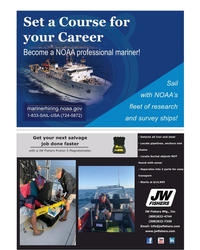 )
March 2024 - Marine Technology Reporter page: 7
)
March 2024 - Marine Technology Reporter page: 7Set a Course for your Career Become a NOAA professional mariner! Sail with NOAA’s fleet of research marinerhiring.noaa.gov 1-833-SAIL-USA (724-5872) and survey ships! - Detects all iron and steel Get your next salvage - Locate pipelines, anchors and job done faster chains with a JW Fishers
-
 )
April 2024 - Maritime Reporter and Engineering News page: 35
)
April 2024 - Maritime Reporter and Engineering News page: 35. The academy program also includes reduce the time they need to spend on a simulator. This saves gas handling operations and engine room simulation courses time and money and frees up simulator time for others. offered by GTT Training and the Thet Training Center. Once onboard the simulator, seafarers
-
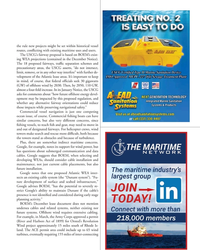 )
April 2024 - Marine News page: 23
)
April 2024 - Marine News page: 23not intersect, limit, remove, or in any other way interfere” with further de- velopment of the Atlantic lease areas. It’s important to keep in mind, of course, that federal of? cials seek 30 gigawatts (GW) of offshore wind by 2030. Then, by 2050, 110 GW, almost a four-fold increase. In its January Notice
-
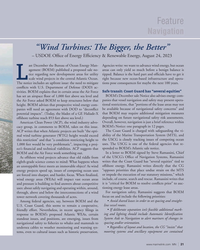 )
April 2024 - Marine News page: 21
)
April 2024 - Marine News page: 21, focus. When ? nalized, or impede the execution of our statutory missions,” which wind energy areas (WEAs) will impact vast ocean areas include, of course, search and rescue. Ramassini writes that and pressure is building to ? nd answers about competitive it is “critical for BOEM to resolve con? icts
-
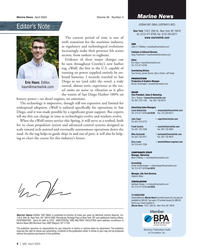 )
April 2024 - Marine News page: 4
)
April 2024 - Marine News page: 4in and out of port, it will also be help- Mike Kozlowski • [email protected] Tel: 561-733-2477 Fax: 561-732-9670 ing to chart the course for this industry’s future. Gary Lewis • [email protected] Tel: 516-441-7258 CORPORATE STAFF Manager, Marketing
-
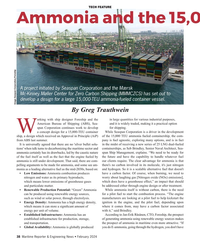 )
February 2024 - Maritime Reporter and Engineering News page: 38
)
February 2024 - Maritime Reporter and Engineering News page: 38, based on: and hydrogen. So it is a scalable alternative fuel that doesn't • Low Emissions: Ammonia combustion produces have a carbon factor. Of course, when burning, we need to nitrogen and water as its primary byproducts, worry about laughing gas [Nitrogen oxide (NOx) emissions], which means
-
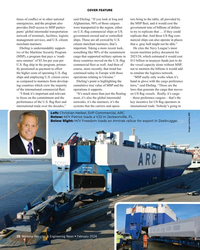 )
February 2024 - Maritime Reporter and Engineering News page: 28
)
February 2024 - Maritime Reporter and Engineering News page: 28.S. ? ag ship in the program, primar- commercial ? eet as well. And then of the vessel capacity alone without MSP, ily positioned as payment to offset course, more recently, that trend has not to mention the billions it would add the higher costs of operating U.S.-? ag continued today in Europe with
-
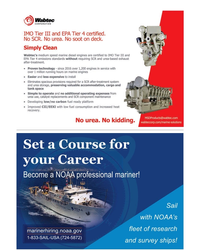 )
February 2024 - Maritime Reporter and Engineering News page: 7
)
February 2024 - Maritime Reporter and Engineering News page: 7Set a Course for your Career Become a NOAA professional mariner! Sail with NOAA’s fleet of research marinerhiring.noaa.gov 1-833-SAIL-USA (724-5872) and survey ships! MR #2 (1-17).indd 7 2/6/2024 4:19:02 PM
-
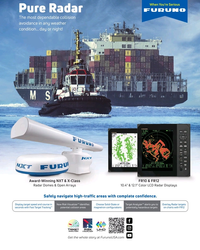 )
February 2024 - Maritime Reporter and Engineering News page: 3
)
February 2024 - Maritime Reporter and Engineering News page: 3navigate high-traffic areas with complete confidence. Target Analyzer™ alerts you to New Risk Visualizer™ identifies Display target speed and course in Choose Solid-State or Overlay Radar targets potentially hazardous targets potential collision areas seconds with Fast Target Tracking™ magnetron
-
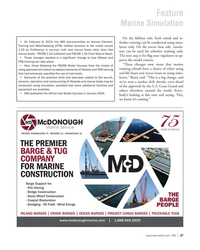 )
February 2024 - Marine News page: 37
)
February 2024 - Marine News page: 37, the IMO sub-committee on Human Element, fresher training can be conducted using simu- Training and Watchkeeping (HTW) rati? ed revisions to the model course lators only. On the rescue boat side, simula- 1.23 on Pro? ciency in survival craft and rescue boats other than fast tors can be used for refresher
-
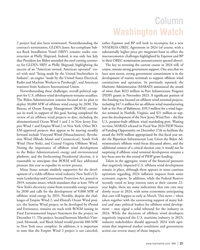 )
February 2024 - Marine News page: 21
)
February 2024 - Marine News page: 21the rather Equinor and BP will look to recompete for a new contract’s termination, GLDD’s Jones Act-compliant Sub- NYSERDA OREC Agreement in 2024 (of course, with a sea Rock Installation Vessel (SRIV) remains under con- substantially higher price per megawatt-hour to offset the struction at Philly Shipyard
-
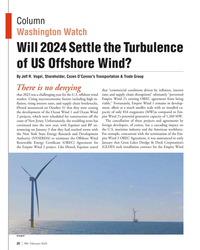 )
February 2024 - Marine News page: 20
)
February 2024 - Marine News page: 20, the troubling news has The cancellation of these projects and agreements by continued into the new year, with Equinor and BP an- foreign developers, of course, has a cascading impact on nouncing on January 3 that they had reached terms with the U.S. maritime industry and the American workforce. the New
-
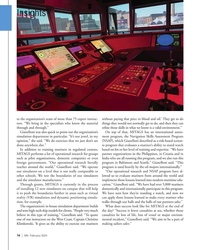 )
February 2024 - Marine News page: 14
)
February 2024 - Marine News page: 14as a risk-based scenar- done anywhere else.” io program that evaluates a mariner’s ability to stand watch In addition to training mariners in regulated courses, based on his or her level of training and expertise. “We have MITAGS performs a lot of operational research for groups partner organizations in
-
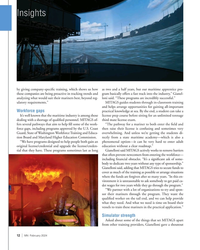 )
February 2024 - Marine News page: 12
)
February 2024 - Marine News page: 12practical knowledge at sea. By the end, a student can take a Workforce gaps It’s well known that the maritime industry is among those license prep course before sitting for an unlimited tonnage dealing with a shortage of quali? ed personnel. MITAGS of- third mate license exam. fers several pathways
-
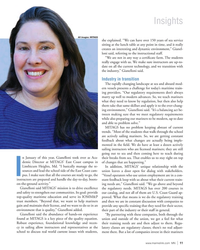 )
February 2024 - Marine News page: 11
)
February 2024 - Marine News page: 11with the sources and lead the school side of the East Coast cam- union leaves a door open for dialog with stakeholders. pus. I make sure that all the courses are ready to go, the “Vessel operators who use union employment are in a con- I instructors are prepared and handle the day-to-day, boots- stant
-
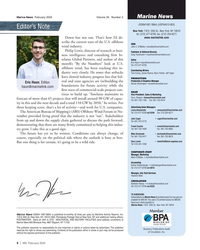 )
February 2024 - Marine News page: 4
)
February 2024 - Marine News page: 4has yet to be written. Conditions can always change, of Mike Kozlowski • [email protected] Tel: 561-733-2477 Fax: 561-732-9670 course, especially on the political side where the outlook is hazy at best. Gary Lewis • [email protected] But one thing is for certain
-
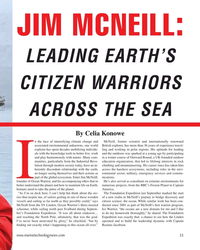 )
January 2024 - Marine Technology Reporter page: 35
)
January 2024 - Marine Technology Reporter page: 35tools to better live, work and the outdoors was sparked at a young age by participating and play harmoniously with nature. Many com- in a winter course of Outward Bound, a UK-founded outdoor munities, particularly from the Industrial Revo- education organization, that led to lifelong interests in
-
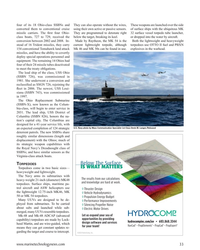 )
January 2024 - Marine Technology Reporter page: 33
)
January 2024 - Marine Technology Reporter page: 33wire-guided, which ® ® ® ® NavCad • PropElements • PropCad • PropExpert for your team! means they can get constant updates re- garding the target and course to intercept. ©2024 HydroComp, Inc. www.marinetechnologynews.com 33 MTR #1 (18-33).indd 33 1/30/2024 7:08:07 P
-
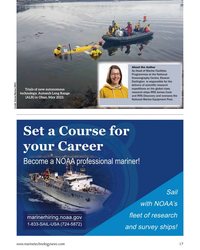 )
January 2024 - Marine Technology Reporter page: 17
)
January 2024 - Marine Technology Reporter page: 17, Autosub Long Range and RRS Discovery and oversees the (ALR) in Oban, May 2023. National Marine Equipment Pool. Credit: Rachel Marlow (NOC) Set a Course for your Career Become a NOAA professional mariner! Sail with NOAA’s fleet of research marinerhiring.noaa.gov 1-833-SAIL-USA (724-5872) and survey
-
 )
January 2024 - Maritime Reporter and Engineering News page: 39
)
January 2024 - Maritime Reporter and Engineering News page: 39the ceiling height, recycling the air from the very top advanced monitoring and preventative maintenance on on- ceiling level, but also, instructing, of course, the shipowners board catering equipment could extend the lifespan of a ship’s about this,” Tenovuo said, noting that some cruise operators galley
-
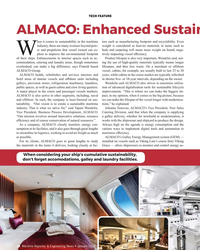 )
January 2024 - Maritime Reporter and Engineering News page: 38
)
January 2024 - Maritime Reporter and Engineering News page: 38is supplying “Our mission revolves around innovative solutions, resource a galley delivery, whether for newbuild or modernization, it ef? ciency and of course conservation of natural resources.” works with the shipowner and shipyard to produce the design. As a company, ALMACO closely monitors energy con-
-
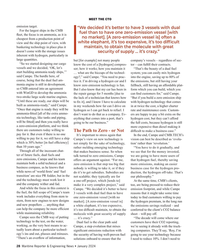 )
January 2024 - Maritime Reporter and Engineering News page: 28
)
January 2024 - Maritime Reporter and Engineering News page: 28technol- system; you can easily mix hydrogen said Campe. The hurdle here, of ogy?,” said Campe. “You need to prac- into the engine, saving up to 80% of course, being that the dual fuel am- tice it. I’m driving a hydrogen car and I the emissions, but still having your monia engine is still in development
-
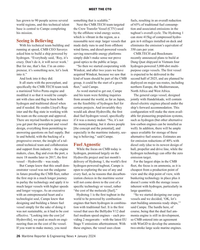 )
January 2024 - Maritime Reporter and Engineering News page: 26
)
January 2024 - Maritime Reporter and Engineering News page: 26with traditional fuel. It is the ? rst said Campe. The hurdle here, of was not sustainable, as it had to be cost vessel that uses the BeHydro V12 dual course, being that the dual fuel am- effective. “Looking into the cost [of fuel medium speed engines – each pro- monia engine is still in development, Hydroville
-
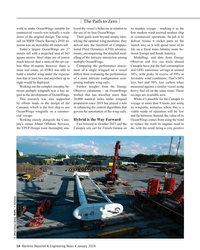 )
January 2024 - Maritime Reporter and Engineering News page: 14
)
January 2024 - Maritime Reporter and Engineering News page: 14route be- meters tall with a projected area of 363 ments, encompassing the detailed mod- tween Europe and South America. square meters. Steel ships are of course elling of the intricate interaction among Modelling, and data from Energy much heavier than a state-of-the-art car- multiple OceanWings. Observer
